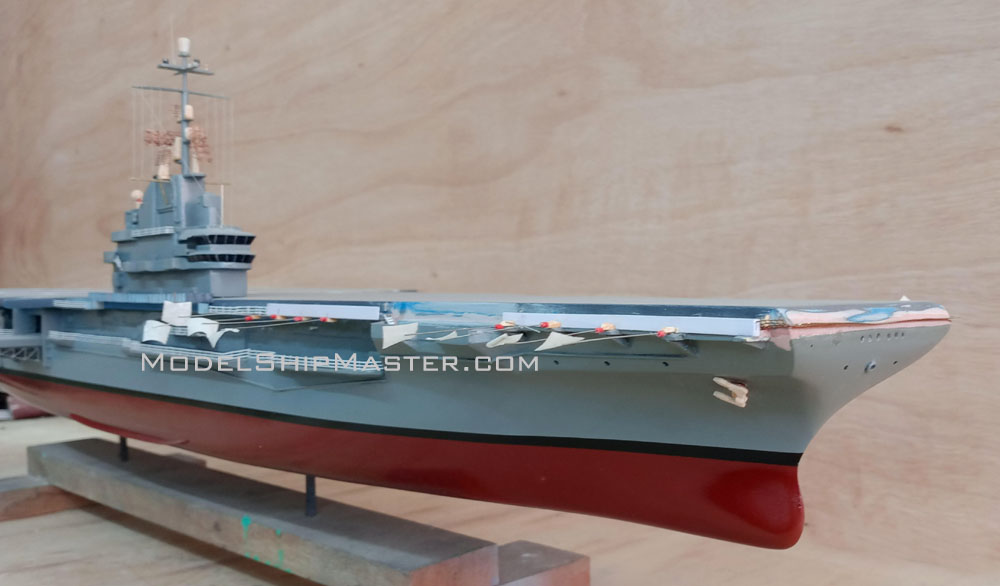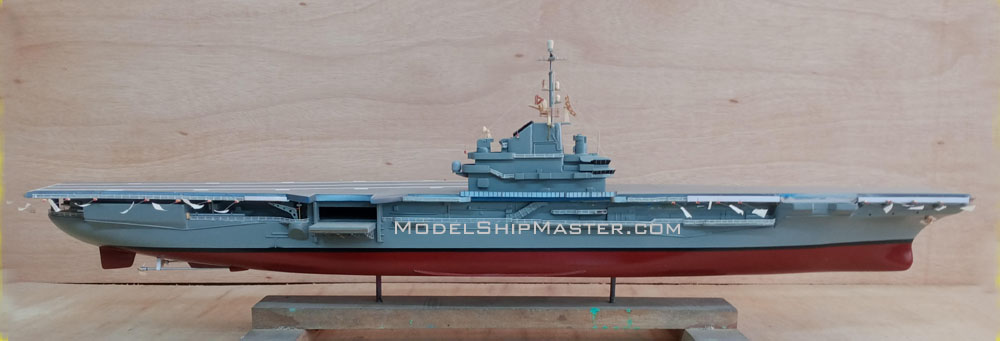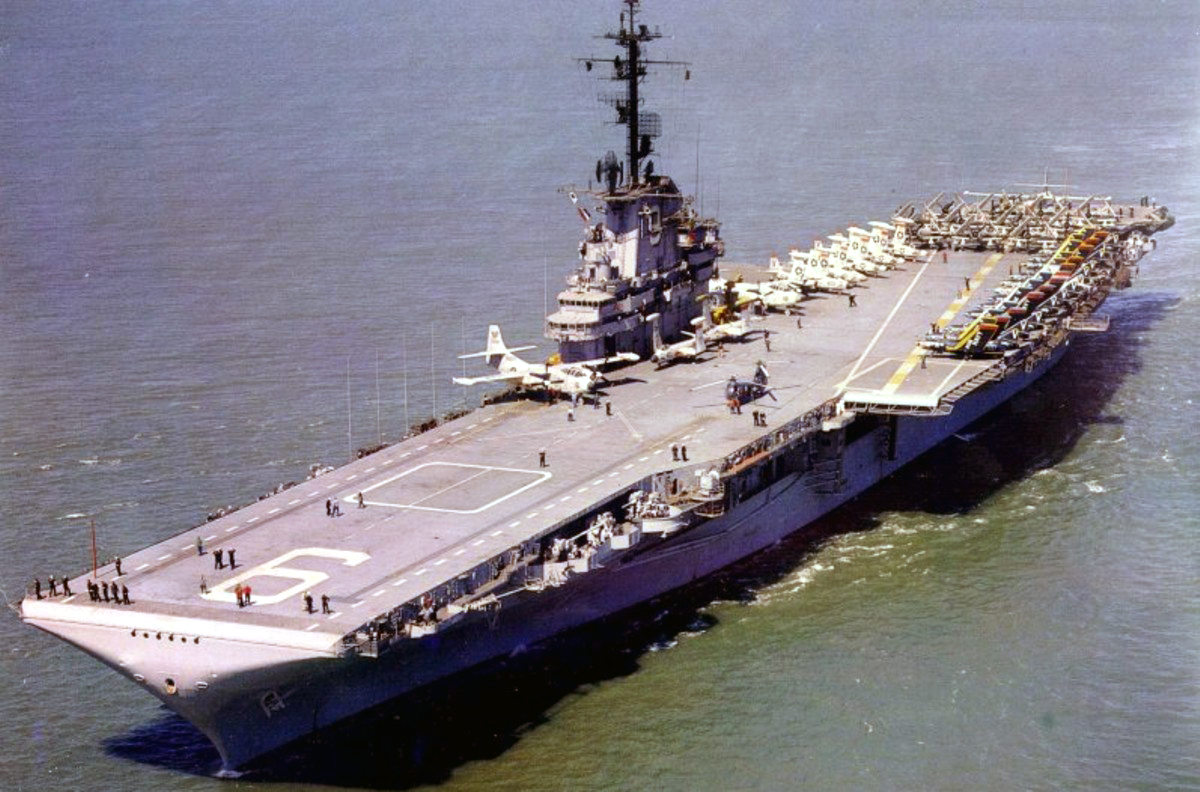|


256-bit encryption
$500,000 protection

|
ESSEX CLASS AIRCRAFT CARRIER
The USS Essex class aircraft carrier was the 20th century's most numerous
class of capital ship-- consisted of 24 vessels..
These ships became the backbone of the U.S. Navy's combat
strength during World War II, with fourteen carriers
engaged in combat operations during World War II.
The Essex class aircraft carriers continued to be the
heart of U.S. naval strength until the 1960s. Some ships
served until after the end of the Vietnam War.

The Essex class was born after the
abrogation of disarmament treaties by Japan in 1936. Naval
Expansion Act of Congress passed in 1938
increased 40,000 tons in aircraft carriers. This
ensued the building of Hornet, which was the
third Yorktown-class carrier, and Essex--the lead
ship of a new class.
Designed to carry a larger air group, USS Essex was over
sixty feet longer, nearly ten feet wider, and more than
a third heavier than the previous class.
The original design assumed a complement
of 215 officers and 2,171 enlisted men. However, by the
end of World War II, most crews were 50% larger than
that.
In drawing up the preliminary design for Essex class
aircraft carrier, particular attention was directed at
the size of both the flight and hangar decks. Aircraft
design had come a long way from the comparatively light
planes used in carriers during the 1930s. Flight decks
now required more takeoff space for the heavier aircraft
being developed. Moreover, US carrier doctrine was
premised on the "deck-load strike", launching as rapidly
as possible as many aircraft as could be spotted on the
flight deck beforehand.
One innovation in the Essex class was a
portside deck-edge elevator in addition to two inboard
elevators. There would be no large hole in the flight
deck when the elevator was in the "down" position, a
critical factor if the elevator ever became inoperable
during combat operations. Its new position made it
easier to continue normal operations on deck,
irrespective of the position of the elevator.
Essex class carriers had
better armor protection, better
facilities for handling ammunition, safer and greater
fueling capacity, and more effective damage control
equipment. These
features, plus the provision of more anti-aircraft guns,
gave the ships much enhanced survivability. That's why
none of the Essex class carriers were lost in WW II.

We build
this Essex class aircraft carrier model the following sizes:
- 30" long (1/350
scale) $3,580 Shipping and insurance in
the contiguous USA included.
Other places: $300 flat rate. Will be completed soon.
- 53" long (1/200
scale) $5,930 Shipping and insurance in
the contiguous USA included.
Other places: $500 flat rate.
The following aircraft are
included: F-4, F-8, A-7 Corsair, E-1B Tracer, SH-2
Seasprite, SH 3 sea king, E-2 Hawkeye.
If you want different
versions,
just let us know. Note that modernization was a bit
different for each aircraft carrier and was divided into four
groups (SCB-27A, SCB-27C, SCB-125, SCB-125A.)
Nobody builds better
warships than ModelShipMaster.
Click
here
to find out. And click
here for our guarantee.

|
Hull no. |
Ship |
Re-designations |
|
CV-9 |
USS Essex |
CVA-9, 1952 / CVS-9, 1960 |
|
CV-10 |
USS Yorktown |
CVA-10, 1953 / CVS-10, 1957 |
|
CV-11 |
USS Intrepid |
CVA-11, 1952 / CVS-11, 1961 |
|
CV-12 |
USS Hornet |
CVA-12, 1953 / CVS-12, 1958 |
|
CV-13 |
USS Franklin |
|
|
CV-14 |
USS Ticonderoga |
CVA-14, 1954, CVS-14, 1969 |
|
CV-15 |
USS Randolph |
CVA-15, 1953 / CVS-15, 1959 |
|
CV-16 |
USS Lexington |
CVA-16,1955 / CVS-16, 1962 / CVT-16, 1969 /
AVT-16, 1978 |
|
CV-17 |
USS Bunker Hill |
|
|
CV-18 |
USS Wasp |
CVA-18, 1952 / CVS-18, 1956 |
|
CV-19 |
USS Hancock |
CVA-19, 1952 / CV-19, 1975 |
|
CV-20 |
USS Bennington |
CVA-20, 1952 / CVS-20, 1959 |
|
CV-21 |
USS Boxer |
CVA-21, 1952 / CVS-21, 1956 / LPH-4, 1959 |
|
CV-31 |
Bon Homme Richard |
CVA-31, 1952 |
|
CV-32 |
USS Leyte |
CVA-32, 1952 / CVS-32, 1953 |
|
CV-33 |
USS Kearsarge |
CVA-33, 1952 / CVS-33, 1958 |
|
CV-34 |
USS Oriskany |
CVA-34, 1952 / CV-34, 1975 |
|
CV-35 |
USS Reprisal |
|
|
CV-36 |
USS Antietam |
CVA-36, 1952 / CVS-36, 1953 |
|
CV-37 |
USS Princeton |
CVA-37, 1952 / CVS-37, 1954 / LPH-4, 1959 |
|
CV-38 |
USS Shangri-La |
CVA-38, 1952 / CVS-38, 1969 |
|
CV-39 |
USS Lake Champlain |
CVA-39, 1952 / CVS-39, 1957 |
|
CV-40 |
USS Tarawa |
CVA-40, 1952 / CVS-40, 1955 |
|
CV-45 |
USS Valley Forge |
CVA-45, 1952 / CVS-45, 1953 / LPH-8, 1953 |
|
CV-46 |
USS Iwo Jima |
|
|
CV-47 |
USS Philippine Sea |
CVA-47, 1952 / CVS47, 1955 |
Learn more about the
Essex class here:
https://en.wikipedia.org/wiki/Essex-class_aircraft_carrier
|